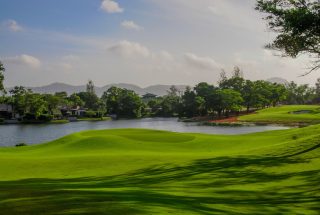OSPREY, Fla. – The Eagle Course at The Oaks, a private 18 just south of Sarasota, has reopened following a major renovation by Arthur Hills/Steve Forrest and Associates. The Eagle is believed to be the first course in the country planted entirely in SeaIsle Supreme paspalum.
Fairways. Tees. Rough areas. Greens. Wall to wall.
Roughs will be cut at approximately 1.5 inches, fairways at less than 0.5 inch and greens as low as 0.1 inch.
"My understanding is that SeaIsle Supreme is planted in certain areas on some courses, but not wall-to-wall," said Brian Yoder, the Hills/Forrest partner directing The Oaks project. "This should be the first one out of the block. And it will help the club differentiate itself from its competition."
Seashore paspalum, and particularly SeaIsle Supreme, has become increasingly popular as a golf course turf because of its ability to 1) thrive when irrigated with poor quality water, such as salt-laden effluent or high-bicarbonate well water like that at The Oaks; 2) require less water, fertilizers and most pesticides than bermudagrass; 3) stripe up beautifully and please the eye with its dark-green color; 4) prop the ball up higher because of its dense canopy; and 5) provide a fast, true putting surface.
Yoder also noted that, because of its waxy leaves, SeaIsle Supreme does not hold the early-morning dew like bermudagrass, meaning players will find their shoes, socks and pants stay much drier.
Lower-handicap players sometimes take awhile to adjust to the way the thicker paspalum turf grabs the ball, as compared to bermudagrass, says Oaks superintendent Earl McMinn. The ball does not bump and run as easily as it does on bermudagrass. "A good player with a variety of shots around the green might have to use more pitch or flop shots around the green," the superintendent added.
The biggest advantage of planting the course entirely with SeaIsle Supreme paspalum will be realized in the future. With Florida under heavy development pressure, many believe it is only a matter of time before potable water will be unavailable for most courses. Effluent may be the only option, and those courses planted in paspalum will be in the best shape to prosper.
Yoder and McMinn decided to go with SeaIsle Supreme in July 2004, when The Oaks retained Hills/Forrest to draw up a master plan. Among the architect’s recommendations were improvements to the practice area, teeing grounds, drainage, bunkering, greens, ponds, perimeter landscaping, interior landscaping, cart paths and irrigation. Implementation would naturally enhance strategic and aesthetic characteristics while creating a championship-caliber layout that is friendly for players of all abilities.
"The renovated course is a huge improvement in terms of aesthetics and playability," McMinn said in February, as the new paspalum fairways grew in thicker and hardier. "Art Hills/Steve Forrest did a good job making it visually appealing and a challenge for all levels of golfers.
"It was a very smooth relationship. Brian Yoder was the main guy here on a weekly basis and was very easy to work with. I have nothing but the highest praise for him. Art Hills is a big name and a very gifted architect. It was a great experience to work with him as well."
The key, Yoder said, was adding improved drainage throughout the course. Hills/Forrest pitched fairways a minimum 3 percent to quickly move runoff water to the inlets and allow turf to dry rapidly following heavy rains.
"If you have dry turf you have good turf.," Yoder said. "Superintendents like us because we put a lot of drainage in.
Hills/Forrest changed many of the tees from curvilinear to rectangular, which aid the golfer directionally and provide a clean, crisp look.
The Toledo, Ohio-based firm, which has worked on roughly 30 Southwest Florida layouts, is renowned for minimizing the number of bunkers for both playability and maintenance reasons. The Eagle has fewer than 50 bunkers. Many have grass faces, which are particularly helpful in The Sunshine State, where heavy downpours can cause washouts that speed contamination of bunker sand.
Hills/Forrest also erected a significant amount of berming and landscaping around the exterior of the property to minimize views of surrounding roadways, residential areas and an electrical substation.
Yoder enhanced existing water features by reshaping several ponds, removing bulkheads and relocating putting surfaces closer to shorelines to bring water hazards more into play.
The 199-yard, par-3, 3rd hole – one of Yoder’s favorites – is a good example. "We took out a land bridge right in front of the hole and put in a timber bridge pretty much out of sight," he said. "The pond is now more visible and the hole much prettier. The neighboring homes have a long view of the water. We put in a big, 8,000-square-foot green flowing back from the water’s edge, providing numerous cupping possibilities, and added some bunkering."
Water is likewise the dominant feature on the dramatic, 542-yard finishing hole. A large pond hugs the entire right side of the par-5 18th. The distance to carry the water has been shortened, which should help higher-handicap players. A pot bunker provides some eye candy in front of a green lying strategically at the water’s edge, with the massive, Georgian-style clubhouse in the background.
McMinn and Yoder put the project out to bid in 2005 and closed The Eagle in March 2006. The Pete Dye-designed Heron Course has remained open throughout and will undergo renovations in the near future.
For more information on Arthur Hills/Steve Forrest and Associates, visit www.arthurhills.com, or call 419-841-8553.
Contact:
Hal Phillips
Phillips Golf Media
207-926-3700
onintwo@maine.rr.com



